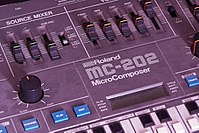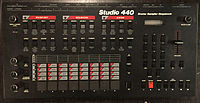 Movement Computer Systems Drum Computer (or Percussion Computer) (c. 1981, UK)
Movement Computer Systems Drum Computer (or Percussion Computer) (c. 1981, UK)This machine consists of:
and it fulfills a definition of left. Electronic Music Studios (EMS) Synthi AKS (1972, UK), consisted of
Electronic Music Studios (EMS) Synthi AKS (1972, UK), consisted of
- Analog synthesizer
- Knobs
- Digital music sequencer with a touch-plate keyboard for input
 Firstman SQ-01 (1980)
Firstman SQ-01 (1980) Roland MC-202 (1983)
Roland MC-202 (1983) Linn 9000 (1984)
Linn 9000 (1984) Sequential Circuits Studio 440 (1986)
Sequential Circuits Studio 440 (1986) E-mu SP-12 (1986)
E-mu SP-12 (1986) Akai MPC60 (1988)
Akai MPC60 (1988) Roland MC-303 (1996)
Roland MC-303 (1996)
A groovebox is a self-contained electronic or digital musical instrument for the production of live, loop-based electronic music with a high degree of user control facilitating improvisation. The term "Groovebox" was originally used by Roland Corporation to refer to its MC-303, released in 1996. The term has since entered general use, and the concept dates back to the Movement Computer Systems Drum Computer in 1981 and Fairlight CMI Page R in 1982.
A groovebox consists of three integrated elements.
- One or more sound sources, such as a drum machine, a synthesizer, or a sampler
- A music sequencer
- A control surface that is a combination of knobs (potentiometers or rotary encoders), sliders, and/or buttons, and display elements (LEDs and/or an LCD screen)
The integration of these elements into a single system allows the musician to rapidly construct and control a pattern-based sequence, often with multiple instrumental or percussion voices playing simultaneously.
These sequences may also be quickly chained together into a song in a live performance. Grooveboxes allow sequences and songs to be saved, retrieved from memory, and inserted into the current performance whilst playing. In some cases, an entire musical performance may be created by a single player with a single groovebox. In other cases, the groovebox is simply one instrument amongst many. This is reflected by the large variety of grooveboxes available, ranging from Roland's lower-end MC and SP products with include basic sequencing and sampling capabilities, to Akai's flagship MPC 4000 and 5000, Yamaha's RS7000 or Roland's own MV-8800 which include features such as high-end sampling, high-polyphony synthesizers, and extensive sequencing, connection and storage possibilities.
Groovebox style instruments have facilitated many performers, both amateur and professional, who may have previously been unfamiliar with electronic music, to explore the genre. Whilst some in the genre initially derided these instruments (in particular the MC-303) and the opening of the field as leading to a drop in standards, they are now generally accepted as having a legitimate place in the form. In addition, many performers and bands from outside the electronic community have integrated groovebox instruments into their shows, as a convenient way of incorporating electronic sound into a more traditional format. The sequencer and control aspects of a groovebox may be used to control an external instrument over MIDI, and the internal voices may similarly be controlled by external equipment.
A groovebox is similar to a music workstation. The general differences are that it will often omit, or include only a simplified keyboard, is designed to be portable, and will usually include more user controls. Whereas a workstation is often targeted towards studio musicians and composers, grooveboxes are designed more to suit the needs of live performers. However, units matching either description are used both on stage and in the studio. A defining characteristic of a groovebox is the ability for the performer to alter both the sequence and the sound parameters in real time, without interruption of the performance. Units marketed as such, which have failed to implement this feature correctly, or at all, have not been well received.
Roland Groovebox may also be compared to drum machines such as the earlier Roland TR series (606, 808, 909 etc.), or to their TB-303, and the term has retroactively been applied to such units.
Models
In the entry order of each manufacturer:
- 1972: Electronic Music Studios (EMS) Synthi AKS (analogue synthesizer with an embedded digital music sequencer and a touch-plate keyboard for input)
- 1980: Firstman SQ-01 (step sequencer with embedded analogue synthesizer and knob controllers)
- 1981: Movement Computer Systems's Movement Drum System I (1981), Movement Drum System II (1983)
- 1983: Roland Corporation's MC-202 (1983–1985) (analogue synthesizer based on SH-101 with an step sequencer and a push button keyboard for input)
- 1984: Linn Electronics's Linn 9000 (1984–1986)
- 1986: Sequential Circuits Studio 440 (1986–1987)
- 1986: E-mu Systems SP-12 (1986), SP-1200 (1987), Launch-Pad (1996), Command Stations XL-7, MP-7, PX-7 (2001)
- 1986: Korg DDD-1 (1986), Electribe series (1999–), Monotribe (2011), Volca series (2013)
- 1986: Yamaha RX5 (1986), RX7 (1987), SU700 (1998), RM1x (1999–2002), RS7000 (2001), DX200 (2001), AN200 (2001)
- 1988: Akai's MPC series — MPC60 (1988), MPC60 II (1991), MPC500 (2006), MPC1000 (2003), MPC2000 (1997–2000), MPC2000XL (1999–2004), MPC2500 (2005), MPC3000 (1993), MPC4000 (2002–2008), MPC5000 (2008–2012), MPC One (2020), MPC Live (2017-2020), MPC Live II (2020), MPC X (2017)
- 1996: Quasimidi QM-309 Rave-o-lution (1996)
- 1996: Roland Groovebox MC-303 (1996–1997), MC-505, MC-307, MC-09, D2, MC-909, MC-808, SP-404, SP-606, SP-808, SP-555, MV-8000 (2003–2006), MV-8800 (2007–2010), EF-303, SH-32, MC-101 (2019), MC-707 (2019)
Note: Roland's trademark "Groovebox" has been used since 1996, that is ten years after the establishments of generic Groove machines E-mu SP-12 in 1986. - 1997: Ensoniq ASR-X (1997)
- 1998: Boss Corporation's SP-202, SP-303 (2001), SP-505 (2002)
- 1999: Zoom Corporation Sampletrak ST-224 (1999)
- 2004: Elektron Monomachine (2004–)
- 2004: Radikal Technologies Spectralis 1 (2004), Spectralis 2 (2009)
- 2009: Native Instruments Maschine (2009–)
- 2010: Beat Kangz Electronics's Beat Thang (2010–)
- 2015: Novation Circuit
- 2016: Pioneer DJ (with Dave Smith) TORAIZ SP-16 (2016), TORAIZ AS-1 (2017)
References
- "Movement MCS Drum Computer". Vintage Synth Explorer.
- "Roland MC-303 GrooveBox". Roland U.S. June 1996. Retrieved 2009-03-31.
- Sound on Sound articles on grooveboxes
- "Multivox International". SYNRISE (in German). Archived from the original on 2003-04-20.
- Roland MC-202 MicroComposer, Electronic Musician, November 2001
- Johnson, Derek; Poyser, Debbie. "Zoom Sampletrak ST-224". Sound on Sound (January 1999).
- "Musikmesse 2016: Pioneer reveals TORAIZ SP-16 sampler, complete with Dave Smith analogue filters". Tech News. MusicRadar. Future Publishing. 2016-04-05.
- "Pioneer DJ revails debut analog synth, the TORAIZ AS-1 - Dave Smith & Pioneer DJ team up…". News. DJ Magazine. Thrust Publishing. 2017-01-19.